Last Updated on April 3, 2024
Estimated reading time: 12 minutes

By Jim Ferri
Like many travelers to picturesque Passau in Germany’s Lower Bavaria, I also arrived in the city on a river cruise .
We had departed Vienna en route to Amsterdam two days earlier, slipping our mooring as silently as we now slipped up the Danube. Our first stop was in Austria to see the beautiful Melk Abbey. Now, with the Austrian-German border only minutes behind, Passau was tantalizingly close.
It was early morning in October, and I was standing on the deck watching the thin river fog being swept away by the morning sun. I was mesmerized by it all. Woods and mountains to the left and right. Little houses with smoke wafting from their chimneys. Everything so soft and, colorful and picturesque. And quiet. I could barely hear the hull beneath me slicing through the water.
And then, there it was…lovely Passau, a little Lower Bavarian city now seemingly painted onto the riverbank. It oozed postcard perfect.
I stood staring, smitten by Old-World Europe rising out of the light autumn haze on the river. But it wouldn’t be until I stepped ashore in Germany that I realized the extent of Passau’s Old-World charm.
Table of contents
Welcome to Dreiflussestadt
In Germany, Passau sits at the confluence of the Danube, Inn, and Ilz rivers. In fact, Germans call it Dreiflussestadt, the “city of three rivers.” The city was founded by the Romans, and its strategic position also made it an important Roman outpost and trade center.
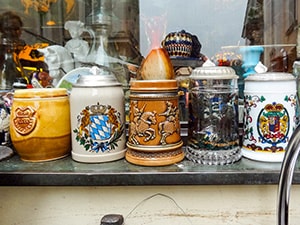
Many river cities, like Passau, thrived through the centuries and became commerce centers. However, with the advent of railroads and airlines in the mid-20th century, most lost their luster. Many became just another sleepy town along the water’s edge.
However, with the incredible rise in river cruising popularity, tourism became an economic boon. River cruises brought travelers who discovered a colorful city of history, art, and architecture. And also, good restaurants and shopping in its colorful little lanes and beautiful squares.
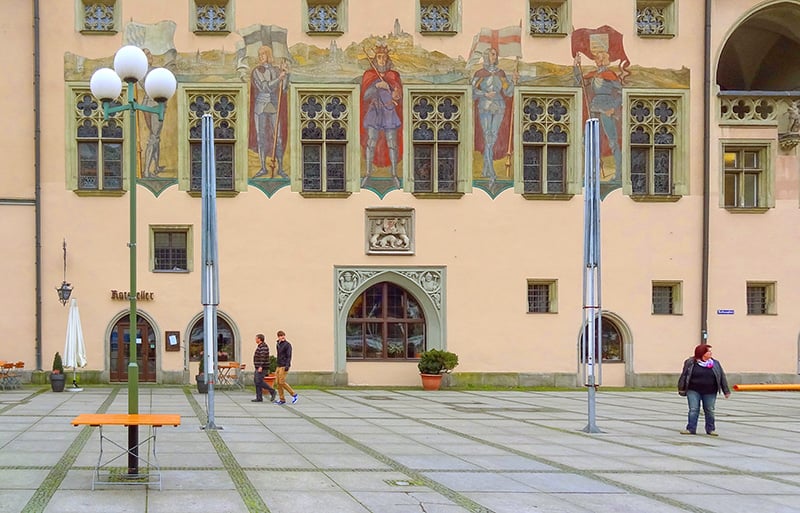
Passau‘s Rathaus
As one of those cruisers, after we docked I joined a small tour group from the ship and walked over to the town’s Rathaus. Surprisingly, we found that the beautiful old Gothic city hall is actually eight patrician houses joined together.

Although its exterior appears a bit plain, it intrigues visitors with the high-water flood markings on its walls. Take one look, and you’ll quickly realize that although Passau’s location was strategic, it was also problematic. Building a city at the confluence of three rivers resulted in significant flooding over the centuries. (The highest occurred in 1501).
All in all, Passau’s Rathaus is a popular tour stop, primarily for its beautifully painted Assembly Room. Outside on Rathausplatz, we saw several tour guides dressed as Empress Elisabeth of Austria. Nicknamed “Sissi,” the future Empress of Austria and Queen of Hungary passed through Passau on her way to Vienna to be married to Franz Joseph I in 1854.
Passau’s Rathaus
Rathausplatz 2
Open: Monday–Wednesday: 8 a.m. – 4 p.m. / Thursday: 8 a.m. – 5 p.m. / Friday 8 a.m. – 12 p.m. Entrance fee: €2

St. Stephan’s Cathedral
As you’ll often find in cities in Germany, Passau’s Cathedral is also a work of art. Passau’s St. Stephan’s Cathedral has stunning blue-green domes and white towers. It’s also the “mother” of St. Stephan’s Cathedral in Vienna.
It’s one of the largest Baroque cathedrals north of the Alps and the site of many churches since 730. Today’s building, however, is the reincarnation of a cathedral destroyed by fire in 1662. It sits at the highest point in the Altstadt, Passau’s old town.
What makes St. Stephan’s Cathedral famous, however, is its incredible organ. It is enormous by organ standards, with 17,974 pipes and 233 registers. In fact, it’s the largest organ in Europe and the largest Catholic church organ in the world.
Of course, as you’d likely expect, organ concerts are popular with visitors here. 30-minute concerts are held daily (except on Sundays and holidays) at noon from May to October. Evening concerts are also held on Thursdays.
A limited number of concert tickets are available on the day you visit from 10:00 a.m. to noon at the ticket office in the Dominnenhof. Admission to the lunchtime concerts begins at 11:20 a.m. via the cathedral courtyard. The Cathedral closes from 10:45 a.m. to 11:20 a.m. in preparation for the concert.
There is also a museum at the Cathedral with displays of art masterpieces ranging from the Romanesque period to the present.
St. Stephen’s Cathedral
Domplatz 7
Open: April – October daily 6:30 a.m. – 7 p.m. / November – March daily 6:30 a.m. – 6 p.m.
The Cathedral closes during organ concerts from 10:45 a.m. to 11:20 a.m.
Entrance to the Cathedral: free
Prices: noon concerts are €2 – €5 and €5 – €10 for evening concerts
Museum At the Cathedral
Residenzplatz 8
Museum entrance fee: €1 – €2.50
Open: May 2 – October 31 / Mon. – Sat. 10 a.m. – 4 p.m. / closed Sundays and holidays
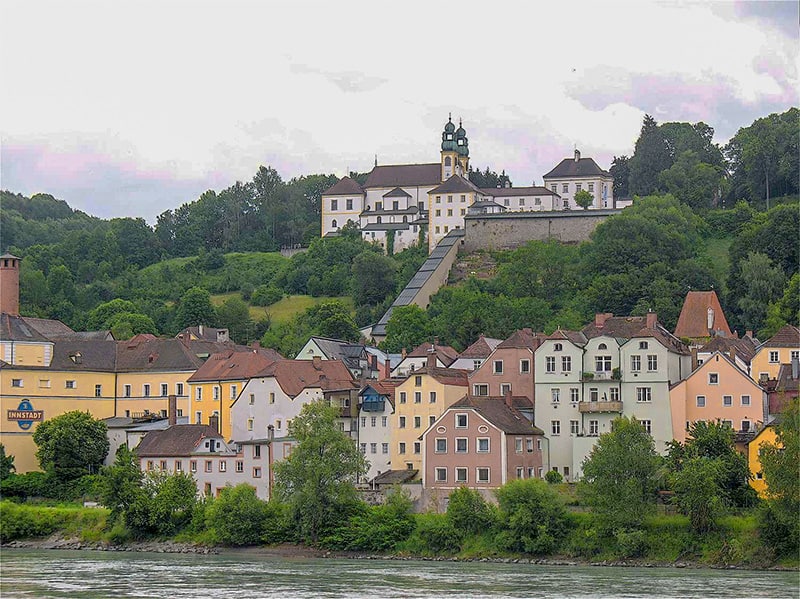
The Pilgrimage Church Mariahilf
If you enjoy visiting churches, you may also want to see Mariahilf on the other side of the Inn River. This 17th-century baroque pilgrimage church was significant as a place of pilgrimage to Saint Mary.
A covered 321-step stairway adorned with votive tablets leads to the pilgrimage chapel. Once inside the chapel, you’ll find a famous painting of Saint Mary above the high altar. However, it is only a copy.
The original was painted for Leopold Archduke of Austria, the Prince Bishop of Passau, who took it with him when he returned to Austria. Before he left Germany, though, a local Passau artist was commissioned to paint the copy now hanging above the altar. The original is in a parish church in Innsbruck, Austria.
Pilgrimage Church “Mariahilf”
Mariahilfberg 3
Entrance fee: free
Entrance to the walkway is from the street Neutorgraben.
Open: daily 7:00 a.m. – 8:00 p.m.
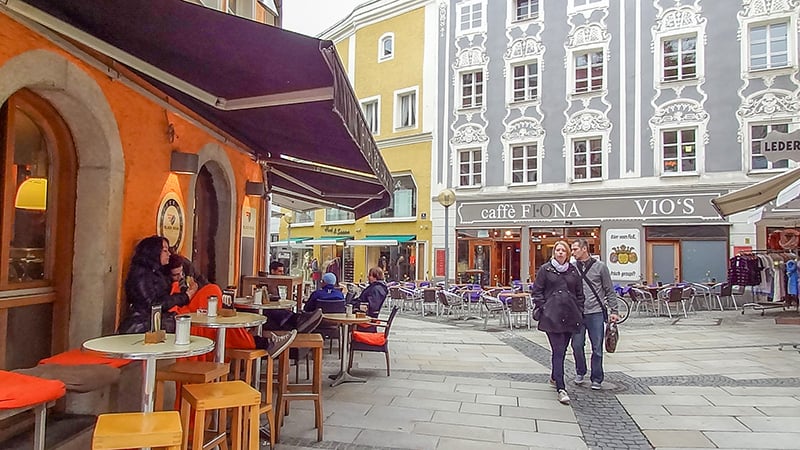
One of the Prettiest Parts of Passau, Germany
Leaving St. Stephan’s, I walked over to the cafes in the nearby Rindermarkt, Passau’s summer cattle market site. Now, though, it was rimmed with cafes, not cows, and had a distinct Old-World aura.
Above all, it’s one of the prettiest parts of Passau, lined with multicolored buildings with little stores and shops. Like a platoon of Pied Pipers, they all enticed me up the street, and I meandered in and out of them for an hour or so.

I soon found myself at the sidewalk-sampling table of a chutney shop, attracting the occasional passer-by. Doing a brisker morning business was a nearby bakery filled with various cakes and strudels.
Walk about Passau in the morning, and you’ll soon realize there is a local café coffee culture. One popular café is the funky little Café Bar Centrale (Rindermarkt 7), seemingly snatched right out of the 19th century. You’ll find more local devotees enjoying their morning coffee at the nearby Black Bean (Heuwinkel 3) and Caffe Fiona (Heuwinkel 6). Many more percolate all over the city.
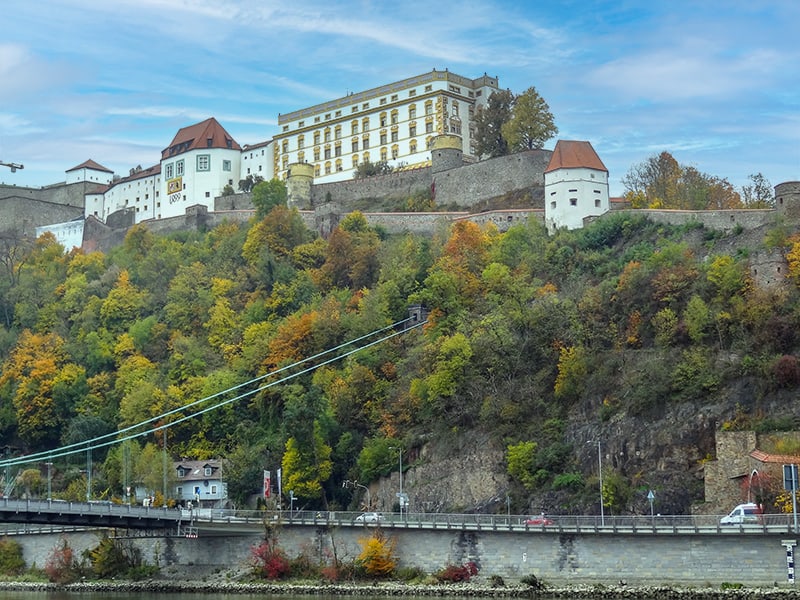
Passau’s Fortress: Fortress Veste Oberhaus
High above Passau on the other side of the Danube is the Veste Oberhaus, the former residence of the prince-bishops. It’s also one of the largest castle complexes that remains intact in Europe and easily reached from the Prince Regent Luitpold Bridge that crosses the river below the fortress.
It’s a historic fortification with numerous exhibitions detailing life in a medieval castle as well as Passau’s history as a trade center. You’ll also find gothic frescos in its chapel of St. George.
Also attracting many who visit the castle, is the opportunity for great views (and photos) of the surrounding area. It’s also the spot where you can see the confluence of Passau’s three rivers – the Danube, the Inn, and the Ilz. And from the castle’s “Battery Linde,” you have a great view of Passau’s picturesque old town.
Veste Oberhaus
Oberhaus 125
Open: March 15 – November 15: Monday – Friday, 9 a.m. – 5 p.m. / Saturday, Sunday, public holidays, 10 a.m. – 6 p.m. / December 25 – January 6, 2025: Daily 10 a.m. – 4 p.m. / closed on New Year’s Eve.
Entrance fee: Adults €5 / Family, 2 adults €10 / Family, 1 adult €8 / Children under 6 years free
https://www.oberhausmuseum.de/en/

Don’t Miss Passau’s Höllgasse

When I finally turned back in the direction of the ship, after a few blocks, I came across Höllgasse. It’s a narrow lane paralleling the river with a line of multicolored painted cobblestones running down the center. The cobblestones caught my eye, and I followed them back towards the Rathaus.
With shops and galleries all along its way, it soon became apparent that Höllgasse was the artistic center of Passau. And it was pretty fascinating. Some of the artists’ works were hanging over the center of the street, several in little frames. This is Old Town’s” artists’ mile,” and many beautiful old buildings are also occupied by studios, workshops, and galleries.
There are no cafes, bakeries, or bars there, as you see on Rindermarkt. And when I visited, there weren’t any crowds either. Just several couples sauntering along, popping into different shops and galleries along the little lane.
If you’re visiting Passau, it’s certainly worth a visit to Höllgasse. There’s an art market twice weekly and wood markets at Christmas.

The Passau Glass Museum
The Passau Glass Museum was cobbled together from four buildings adjacent to the Rathausplatz. It contains the most extensive and amazing collection of European art glass in the world. In fact, UNESCO lists this Passau museum as one of Germany’s “Cultural Properties of National Significance.”
The collection focuses on the 19th century and art nouveau – both the Golden Age of glass. The museum is home to 15,000 pieces on display. It shows the great art and variety of glassmaking in Bavaria, Bohemia, Austria, and Silesia over 300 years (1650 to 1950).

Among its exquisite collections are many masterpieces exhibited during 19th-century World Exhibitions. There are also famous glass pieces created for European royal families. The latter also makes the Passau Glass Museum an important center for glass research.
Within the same historic building, you will also find the four-star “Hotel Wilder Mann.”
Glasmuseum Passau
Schrottgasse 2 (Ecke Rathausplatz)
Open: mid-Feb – December 31 / daily 9 a.m. – 5 p.m.
Entrance fee: Adult €7 / children 6 and younger free
www.glasmuseum.de

New Episcopal Residence: A Rococo Masterpiece
Built in 1730 in the Viennese late Baroque style, the New Episcopal Residence is behind St. Stephan’s Cathedral. It served the Prince Bishops as a residence and a “representative” building where the church’s work was done.
The building stands out from the buildings around it, which is befitting since, at one time, it was the largest diocese of the Holy Roman Empire. Today, it contains the religious riches of Passau’s past. The staircase alone is considered a masterpiece of the Rococo style. Its fresco of the Gods of Olympus highlights the museum’s treasures.
New Episcopal Residence
Residenzplatz 8
Open: daily 10 a.m. – 4 p.m. / closed Saturday and Sunday
You may also enjoy: Day Trips From Munich to 3 Great Bavarian River Towns / Things To Do in Munich / 26 Great European Day Trips by Rail / Bus
If You Go:
German National Tourist Office
122 East 42nd Street, 52nd Floor
New York, NY 10168
Tel: (212) 661-7200
Passau Tourismus e.V.
Rathausplatz 3
94032 Passau
Germany
Tel: +49 – (0)851- 95 59 8 – 11

For anyone who loves medieval architecture, quaint shops AND friendly people – not to mention lots of authentically-local restaurants – Passau is a jewel. It has one of the most upscale Christmas markets in Germany with bespoke finds among the booths. Danke for highlighting Passau; it’s a delight!